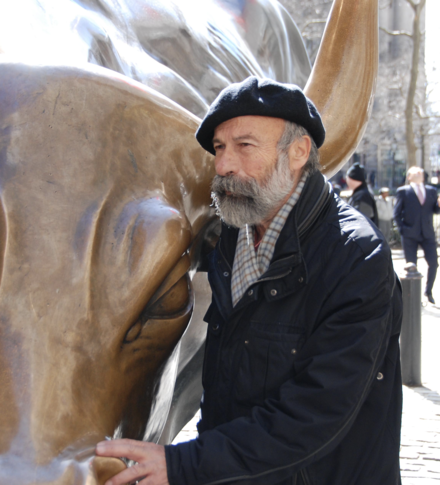Preserving Italian American Heritage
Written in memory of Rosemary Baptiste
My 40-year career has been devoted to preserving ancient jewelry-making techniques, with a particular focus on Roman and Etruscan jewelry history. This year, I had the honor of creating the medals for the Columbus Citizens Foundation's (CCF) 80th Anniversary celebration, which awarded a Grand Marshal and two Honorees.
Medals for the Columbus Citizens Foundation Handcrafted by Donna Distefano Ltd. in New York City.
These medals are crafted in solid sterling silver, measuring 3 inches in diameter, and each medal weighs approximately 77.7 grams.
In the early 1900s through the 1930s, my paternal Sicilian grandparents arrived and settled in New York City, while my maternal grandparents came from Lazio, Italy, to Ellis Island, eventually settling in Bridgeport, Connecticut. Both sides of my family faced varying degrees of cultural discrimination.
My grandmother Salvatrice Giacchi Distefano of Vittoria, Sicily. Photo taken in the 1920s in the Bronx.
My Sicilian grandmother Salvatrice, seated center, surrounded by my Sicilian great grandparents and my great aunts. Around 1910, New York City.
My grandfather, Giovanni Picarazzi (center). When he was 19 and already in America, he was drafted to fight in the United States Army. By this time he was well ensconced in American life- he worked, was educated and became a citizen of the U.S. and was now known as John.
My mother —Virginia Rose Picarazzi, center, surrounded by my grandparents, aunts and uncles. The 1940s in Bridgeport, Connecticut.
Many people don't know that Columbus Day was less about honoring Columbus the person and more about celebrating Italian Americans. The day was proclaimed by President Benjamin Harrison in 1892, following the tragic lynching of 11 Italian immigrants in New Orleans in 1891. This lynching was motivated by widespread anti-Italian sentiment, as the men were falsely accused of murdering the city's police chief and acquitted by a jury. Harrison's proclamation of Columbus Day was aimed at promoting national unity and acknowledging the contributions of Italian immigrants at a time when they faced significant prejudice, with discrimination lasting well into the 1950s and beyond.
The day could very well have been named Giovanni da Verrazzano Day or any other Italian who contributed to America. Italian American immigrants simply did not have awareness of Columbus in a world 500 years prior. To them, the storytelling of his journey represented a symbol of their own crossing of the sea to a new world.
Columbus' legacy is complex and requires a nuanced understanding of his historical role. His 1492 voyage for Spain, whether one likes it or not, was a key moment in world history, marking the beginning of interactions between the Old and New Worlds. However, the European colonization of the Americas that followed diminished the rich histories and cultures that existed long before European contact, as indigenous peoples had been living in the Americas for thousands of years prior to Spain’s arrival. This colonization led to the exploitation, displacement, and deaths of millions of Native Americans through violence and slavery.
While all of that is true, absolutely none of it relates to Italian emigration to America 400 to 500 years later.
Columbus Day was made a federal holiday by Franklin D. Roosevelt in 1934. At that time, my family, mostly entrepreneurs, was in the midst of realizing their American dream. Today, we recognize the irony of witnessing the same persecution faced by new immigrants who experience similar discrimination. All citizens deserve their own national holiday. The beauty of our American melting pot lies in celebrating other cultures while becoming one fabric without losing our individual heritages.
My paternal grandparents 1920's New York City
My Italian American heroes, Joe and Ginny, my parents 1950's
My mom and dad, 1960s, New York
Me in Sicily 1998
The Columbus Citizens Foundation (CCF) was formed in 1929 to celebrate and preserve Italian American heritage and achievements. They support deserving and talented Italian American students with scholarships; their scholarship program has raised nearly $40 million since its inception in 1984! CCF also organizes the annual Columbus Day Parade in New York City, the largest celebration of Italian American heritage in the U.S.
Last night, as of this writing on the eve of Columbus Day 2024, CCF posthumously honored my close friend Arturo di Modica, who passed in 2021. He and my grandmother were from the same small town in Sicily. I met Arturo shortly after he dropped off his “Charging Bull” in New York City’s downtown. For all these decades, whenever I mention his name to people, they generally say, “Who?” Even Italian Americans have been unaware that the iconic statue was created by an Italian American—an originator of ultimate guerrilla marketing—but that’s another story.
Arturo di Modica
A souvenir that Arturo gave me after he made the papers.
I’m heartened that both Arturo and I were represented, in a way—Arturo for his celebrated career and me for creating the recipients' medals—in the same place on the same night in New York City, some 35 years after our creative paths intertwined on Crosby Street. My best friend, Rosemary Baptiste, who passed away this past April, lived with Arturo during those days. We had many celebrations together, and each one involved Italian food, wine, art, culture, and Italian wit, long before it was “cool” to be Italian. We always knew (wink).
Rosemary and me, 2020, Abbazia di Montecassino, Italy













